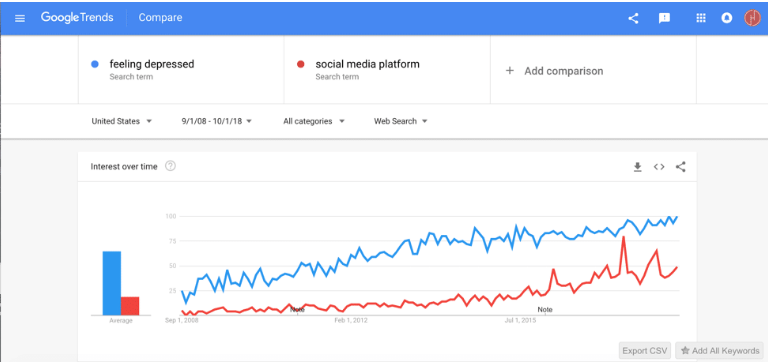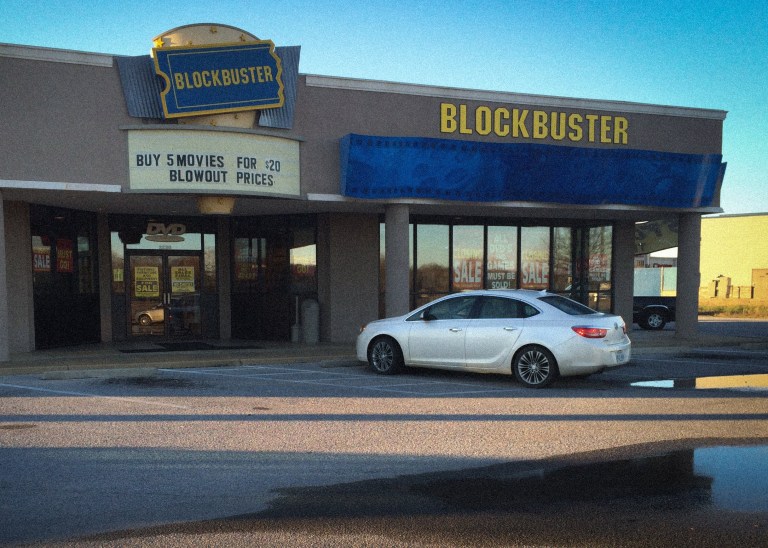7 Bold Predictions About The Future Of Media — And The World At Large
I don’t think people realize just how much the custom internet is dividing us. The algorithms that power our lives – that deliver us food, find us Ubers, and serve up relevant news articles – are so highly honed on who we are and what we like, they actually bend the digital world around us…
By ![]() James Cole
James Cole
My name is James Cole, and I started a company called The Hub. The Hub connects 35,000 photographers, models, and videographers to brands across the world. Brands work with our creators to create content at scale, and our creators help spread the word about their products from their social platforms.
The Hub is young, and I am a first-time founder. That said, my position on the front lines of the media landscape has afforded me access to people, information, and insights that employees my age within the machine don’t get to see.
This post, therefore, is a snapshot of my raw, unfiltered thinking, in the form of seven predictions about the next seven years. It’s as much a chance for me to share with a wider audience what I’ve learned so far as it is for fun and posterity.
1. The “freelancer economy” will become half the US workforce
Today, 55 million Americans work as freelancers or moonlighters. That’s over 35% of the workforce. Last year, they collectively earned over $1.4 trillion, according to Edelman. What’s more, the freelancer subset is growing three times faster than the overall U.S workforce. At this rate, freelancers will be the majority subset by 2027.
Unsurprisingly, with over 47% of them working freelance, Millennials are leading this trend.
Why is this happening?
First, the Amazon economy is generating millions of freelancers jobs. Across every asset class, technology is elegantly directing vast clouds of freelancers to pair consumer demand with corporate supply. Today, thanks to services like Uber, Postmates, Capsule, and Airbnb, consumers can get exactly what they want faster than ever.
These services place freelancers within a large technological web, empowering them to work for ‘themselves,’ on their own schedules. Thanks to the efficiency of the technology, a worker’s output keeps pace with her input. Time in equals value, which equals money out. That equation feels good for everyone. It puts numbers on the board, too: Uber employs nearly one million people in the United States, and in 2016, Airbnb hosts in the US made over $800 million across 91,000 listings.
Even outside freelancer-driven services, though, the freelance model is spreading to the rest of the workforce.
Previously, hiring meant sifting through hundreds of resumes, using proxies like college degrees and SAT scores to gauge a candidate’s competency. This process is inefficient and clunky, like calling a limo/cab service to arrange a pickup. But just as passengers now use Uber to seamlessly find rides, more conventional corporate employers can use services like Upwork, WorkingNotWorking, and The Hub to find talented freelancers with very specific skillsets in seconds.
The barrier to filling your company’s blindspots with the perfect freelancer has never been lower. Community reviews for freelancers, along with search filters like cost, availability, and relevant experience, help corporations to find a perfect match effortlessly. Aptitude tests have been integrated and streamlined into that process, too. Upwork, for example, offers thousands of tests, ranging from specific coding languages, to Social Media Marketing, to Excel, letting employers filter freelancers by what percentile they scored in among everyone who took the respective test.
More broadly, the culture is shifting, too. Coworking spaces are booming. In 2017, We Work accounted for 3.3% of new leases signed in Manhattan. In 2018 they accounted for 9.7%. In fact, just a few weeks ago WeWork became the biggest private office tenant in NYC. With demand continuing to grow, and infrastructure and technology keeping pace to support the supply, I don’t see this trend slackening off any time soon.
2. Most colleges will consolidate or die
I know, crazy right? But listen:
There are too many colleges. They’re only getting more expensive. We’re too in debt to afford them. And there are now much better markers of a qualified job applicant than a diploma.
After WWII, population growth and cultural demand fueled growth for two- and four-year colleges. Since then, the number of higher education institutions has steadily climbed, ballooning 30% in the past 30 years alone. The number of enrollees has grown by 57% over the same time period, jumping from 11.3 million to 17.7 million, according to the National Center for Education Statistics.
Over the last five years, though, both the number of applicants and the number of colleges has decreased – with the pace quickening year-over-year.
Why? I’ll say it again: college is too expensive and we can’t afford it.
Over the last 30 years, the cost of American college has increased 4x, while the median household income has barely budged, from ~$54,000 in 1988 to ~$61,000 today. That delta has led to massive debt. In fact, the U.S student loan debt just recently eclipsed $1.5 trillion for the first time in history. It’s now the second biggest debt category, behind mortgage debt. More than 44 million U.S citizens still owe money to their alma mater (more than $5,000 each).
On top of that, for perhaps the first time in history, a conventional college education leaves graduates ill-equipped for the job market they’re entering. McKinsey asserts that as much as 30% of the global workforce could be replaced by automation by 2030. Already, the 14 million jobs that are outsourced overseas far outstrip the 7.5 million unemployed Americans.
On the other hand, paying a hefty premium to attend lectures and live in student housing makes less and less sense in the face of more sophisticated and scalable digital options. “Charging people lots of money to provide them with skills they could learn from an Internet video…is not going to be a viable long-term financial model,” says Richard Miller, President of Olin College of Engineering. “Knowledge is now a commodity. It’s really inexpensive and easy to get. Who’s gonna pay you for that?”
Experimental education is getting more sophisticated, more customized, and more affordable. With resources like Coursera, Udemy, General Assembly and others, getting surgical, specialized knowledge to pursue a specific career or freelance opportunity is now readily available for pennies on the dollar.
The concept of a college campus won’t die, but it will have to evolve. College will be less about attending lectures or picking a major – in fact, 93% of employers care more about “critical thinking, communication, and problem-solving skills than an undergrad’s concentration – and instead will become about interdisciplinary learning and cultural camaraderie.
Because of technology, our world is changing exponentially faster than it ever has before. To me, taking on massive debt to get a generalized degree in the face of a moving-target job market makes almost no sense.
3. The custom internet will divide us, and then unify us
I don’t think people realize just how much the custom internet is dividing us.
The algorithms that power our lives – that deliver us food, find us Ubers, and serve up relevant news articles – are so highly honed on who we are and what we like, they actually bend the digital world around us to conform to our tastes.
The more content we consume, the more ad revenue the platforms can make off our eyeballs. Netflix, Facebook, Spotify have every incentive to hold your attention as long as they can, and they do it by giving you exactly what you want to read, view, or listen to.
The result? What I consume is so different than what you consume that there is no ‘normal.’ There is no single consensus ‘reality.’ Mine is different than yours. Yours is different than Trump’s. Trump’s is different than your Uber driver’s. Everyone you engage with – digitally, in person, or on a macro, national level – is living their life filtered through different digital experiences and truths. Different facts, even.
Our tastes aren’t the only thing driving that process, either. By understanding what makes us tick, Facebook can sell highly targeted ad space to brands that want to reach us. When brands (or, say, Russians) hit us with highly targeted ads, we’re sitting ducks. They know just what to say and how to say it to get us to like, read, follow, or purchase. And what’s worse, the more we like, read, follow, or purchase, the more we cement our own preferences. The more we consume, the more we lock in who we are, which makes us easier to target, which makes us consume more.
It’s a death spiral. And no, I’m not being dramatic. Thankfully, though, I see a glimmer of hope on the horizon.
Reality has always been subjective. Your experience is yours, and yours alone, undefinable and unsharable. But now, for the first time ever, our worldviews are becoming tangible, concrete, and externalized. The algorithms that know you better than you know yourself can also paint a picture of the inside of your head for someone else. Our personal internets don’t need to isolate us if we can let others step inside them.
Imagine a world in which I could share a ‘password’ to my ‘digital algorithm,’ letting you view the internet (read: the world) exactly as I do. You’d be exposed to the articles I like, the music I listen to, the ads I see. You could experience exactly what I experience, or at least the things that shape my experience. In a world where you could walk a mile in someone’s virtual shoes, maybe we’d all have access to a much-needed dose of empathy.
4. The media-middle-man will die, the future is OTT
Historically, TV shows, radio programs, and articles made their way out into the world by way of powerful gatekeeping middlemen. Broadcast networks like CBS and NBC, radio stations, and publications like Vogue chose what we consumed, when we consumed it, and where we could find it.
Today, though, publishers can go “over-the-top” (OTT) and bypass the middlemen of old. This detour takes many forms – most notably in the wave of “modern TV networks” like Netflix, Hulu, and Amazon Prime, as well as the rise of democratized publishing via social networks like Youtube, Instagram, and Facebook.
As this is happening, though, Americans are very close to ‘peak media consumption.’ Depressingly, the average American spends over 12 hours per day on media and tech consumption, a number that has unsurprisingly skyrocketed over the past decade. However, according to Activate, over the next four years, our tech consumption will only grow by another 18 minutes.
The result? Publishers will fight tooth and nail for those 18 minutes. As the bottleneck narrows, publishers will starve and/or consolidate. When the dust clears, my money is on modern TV networks and social media platforms outliving nearly every incumbent network and publisher.
Already, modern TV networks are growing hand over fist. Nearly all of the aforementioned entities have grown 300-400% in the past three years alone. Moreover, compared the cost of cable television, modern networks cost less than 1/4th the price (per consumer, per hour of viewing), leaving modern networks with more to spend on content. Better content means more viewers. The gap is widening, and it’s widening fast.
Already, the traditional middlemen are losing their access points to new audiences. Many young people don’t actually own a TV, with Gen-Z watching 40% less TV than they did five years ago.
Social media consumption is rocketing, too. Facebook video views have doubled, from 9 billion in 2015 to 19 billion in 2017, Youtube video views have doubled over the same period, from 9 billion to 19 billion. Even Snapchat, with all its stumbles, has doubled its video viewpoint over the same timeframe, from 7 billion to 15 billion.
Unsurprisingly, as the consumer eyeballs double, so does ad revenue. In 2014, Youtube’s ad revenue overtook CBS’s, the largest of the broadcast networks. Since then, it hasn’t even been close.
For consumers, cutting out middlemen means less cost, less delay, and above all, moretransparency. On social media, the people are the publishers, and they make or break the content. View counts, upvotes, and algorithms choose what lives and what dies – not a monolithic boardroom of crusty misogynists.
The last leverage traditional networks still hold is monocultural events like the Super Bowl and the Oscars. But when one of those airs on Amazon or Hulu instead of Fox or ABC, it’s over. Mark my words, it will happen before 2020.
5. Traditional media will account for <25% of total media spend, then stabilize
The shift from traditional media to OTT outlets is going to have serious ramifications for how brands allocate their ad dollars, too. I see the spending pendulum swinging hard towards new media, but I also see it swinging back towards traditional outlets after that.
Already, in the advertising sphere, traditional media like TV, print, and radio are starting to circle the drain. Digital media, and social in particular, are becoming more and more focal to marketing strategies, with digital ad spend accounting for 44% of total media spend in 2016, some $90 billion. TV spend, meanwhile, only accounted for 34% of total media spend that year, about $70 billion.
The biggest beneficiaries of this trend have been the major social networks. In 2017, more than 60% of the US digital media budget — over $50 billion — went to Google and Facebook.
And that trend is intensifying. Overall marketing budgets are surging by 18% year-over-year, and we’re on track to have spent a whopping $107 billion on digital ads in 2018.
For traditional media, that’s another nail in the coffin, at least in the short term. Media consumption is steadily shifting away from traditional outlets, and ad dollars will likely follow suit. Print, in particular, is showing its age, accounting for 16.6% of national ad spend but only 3.3% of daily media consumption. That disparity won’t last long, and it’s unlikely that consumers will suddenly get an overwhelming hankering for physical newspapers. As marketing budgets continue to shift, expect to see even bigger drops in traditional media spending.
All that said, I absolutely don’t see traditional media spend ever dropping to zero. In fact, while this number has been down over the past five years, the average American still watches 8 eight hours of TV per day. Traditional media consumption is dropping, but it seems more like it’s reaching a lowered settling point than going away entirely.
In the next few years, we’ll likely see traditional media spend dip below 25% of total spend as the bottom seems to fall out. However, I see that as marketers over-correcting. Once they realize those eyeballs have actually become undervalued, they’ll readjust, and the numbers will stabilize. We’ve already seen this happen with radio ad spend, which (believe it or not) was up 128% year-over-year last year. So while the media landscape’s rumbling as its tectonic plates shift, it’s not the end of the old world just yet.
6. Most traditional ad agencies will die
Where the ground really is crumbling, though, is under the feet of traditional ad agencies.
The fact is, agencies are fatally under-equipped to adapt to the digital media landscape. First and foremost, they’ve historically made their money off traditional media. And, as I detailed earlier, they’re going down with that ship.
Worse for them, there are now way too many agencies, and they’re stuck fighting over an increasingly small slice of the pie. Consumer attention will only get harder to come by (and harder still to hold). Instead of throwing out the playbook, though, agencies seem to be doubling down on parroting each other’s strategies and messaging. To consumers, that ends up as just a lot of white noise.
Brands, too, aren’t getting their evolving needs met by traditional agencies. For a campaign to thrive, brands need a wealth of trackable metrics. Even in the past six months the insistence on “bottom of funnel metrics” and “tangible ROI” has intensified. They help brands to clearly see who their audience is, how it’s engaging with their message, and how they can adapt and expand. Tech-driven freelancer networks like The Hub can deliver that, while all most traditional agencies track are their billable hours.
Switching from relying on one-track agencies to adaptable networks of freelancers will be a blessing for brands. Agencies operate via top-down vertical communication with creatives, stifling creativity and homogenizing messaging. Freelance networks, on the other hand, thrive off collaboration, encouraging brands and creatives to communicate horizontally. Partners, not bosses. With traditional ad agencies out of the picture, the sky becomes the limit for creative branding.
7. Anti-screen counter-culture will become mainstream
A decade ago, I’d be branded a Luddite for predicting a mainstream backlash against screen culture. Now, I’d say it’s inevitable.
Smartphones have been ubiquitous for the better part of a decade now, and the effects of that are becoming impossible to overlook. 46% of Americans now say they can’t live without their device. “Digital detoxes” have shifted from a Goop-esque indulgence to a necessary breather. Cryptic-sounding phrases like “phantom vibrations,” “blue light,” and “text neck” are now common woes. We’re sick of reflexively jerking our heads when someone else’s phone buzzes. It’s all getting exhausting.
Children, in particular, spend considerably more time on their screens than they do with their friends, their families, and their teachers combined. As anyone who saw Eighth Grade can attest, that constant exposure takes a toll. 13-year-old social media users are 27% more likely to be depressed, and children who use seven or more platforms are three times as likely to have anxious or depressive symptoms.

Meanwhile, we’ve seen more and more of the architects of our screen culture speak out against the world they helped create. Former Apple VPs have gone on the record about how addiction was intentionally hardwired into our iPhones and apps. Earlier this year, ex-Google and Facebook employees founded the Center for Humane Technology to pressure tech companies into designing more ethical, conscientious tech. The Center is also targeting 55,000 public schools with educational campaigns about technology addiction. A real backlash is building, and it’s got some muscle behind it, too.
I don’t think we’ll ever see our smartphones regulated by the ATF or the FDA, but regulations encouraging non-addictive UI and UX might not be that far off. I think we’ll also see some new normals around smartphone etiquette, both in public and private, as families and partners set hard limits on phone use and find ways to enforce them.
We may not be able to live without our phones anymore, but we might finally figure out how to live with them.





